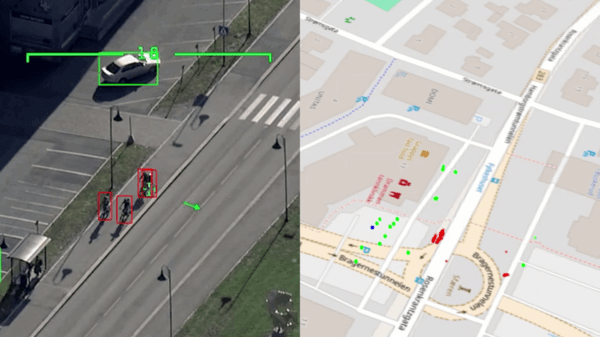Advancing surveillance with AI and ATR integration

FlySight and Aitech Systems integrate OPENSIGHT with A179 Lightning to enhance real-time augmented target recognition capabilities
In the rapidly evolving landscape of law enforcement and aviation, the demand for cutting-edge technology that provides a strategic edge is paramount. FlySight and Aitech Systems have stepped up to this challenge, integrating FlySight’s OPENSIGHT with Aitech’s A179 Lightning artificial intelligence (AI) supercomputer. This collaboration enhances real-time augmented target recognition (ATR) capabilities, offering strategic advantages for operational empowerment.
OPENSIGHT, with A179 Lightning enhancement, acts as a sophisticated remote ATR sensor, capable of acquiring real-time video data from diverse sources. It can seamlessly switch the inference from a local HD-SDI to multiple local or remote STANAG 4609 streams, adapting to various operational scenarios with ease. Essential for law enforcement agencies that need versatile and adaptable tools, and this adaptability ensures effective monitoring across various environments, enhancing its operational ability.
THE ROLE OF AI AND ATR SYSTEMS
For emergency services, having an ‘eye in the sky’ is pivotal to operations. Automatic target detection, classification, and identification have become essential components of daily operations. AI’s adaptive learning techniques have revolutionized helicopter participation in both civilian and military contexts, significantly enhancing the efficiency and accuracy of ATR systems.
THREE ELEMENTS OF ATR SYSTEMS
Detection: ATR systems are programmed to detect multiple targets in a confined area or selectively isolate single targets. Using real-time video streams up to a 30fps frame rate, AI processes data to detect target objects effectively. Classification: once a target is detected, the system classifies it based on parameters such as size or other pre-programmed criteria; for example, a helicopter tracking a large van can eliminate irrelevant data like smaller vehicles or pedestrians, enabling efficient tracking even in complex terrain. Tracking: advanced AI in ATR systems allows for real-time tracking of multiple small targets or a single one. Pre-programmed data sets enable the system to track effectively with minimal deviations, ensuring accurate and reliable performance.
ADDRESSING FALSE DATA CONCERNS
False data is a significant concern with ATR systems, both from a public privacy perspective and an operational efficiency standpoint. However, as AI technology advances, these issues are being mitigated. In less congested environments, like remote search and rescue missions, ATR systems can reliably identify single targets. In urban settings, experienced human operators can work alongside AI systems to eliminate erroneous data effectively.
OPEN ARCHITECTURE FOR ENHANCED FLEXIBILITY
OPENSIGHT’s AI-enabled open architecture allows real-time processing of video sources using a diverse selection of pre-configured and customizable neural networks. This flexibility facilitates the integration of thirdparty or proprietary AI networks, optimizing the advanced functionalities of the TensorRT inference engine and ensuring extensive compatibility through adherence to the ONNX standard.
OPERATIONAL FLEXIBILITY AND STANDARDS COMPLIANCE
Dynamic operational demands require flexible tools. OPENSIGHT enables users to select different runtime networks dynamically and swiftly add them to the system. The ATR module ensures compliance with MISB ST-0903 (VMTI), seamlessly integrating into STANAG 4609 streams. This enhances interoperability with legacy systems, allowing for capability upgrades without overhauling entire infrastructures.
MISSION CONTROL: HEIGHTENED SITUATIONAL AWARENESS
The integration’s output power is displayed in the OPENSIGHT Mission Console. Operators receive both video and mapped georeferenced detections in real-time, providing a comprehensive operational picture crucial for informed decision-making.
THE FUTURE OF AI IN ATR SYSTEMS
AI’s role in ATR systems is set to grow, further integrating into various aspects of law enforcement and special missions. FlySight and Aitech Systems’ groundbreaking integration exemplifies how AI and advanced technology can revolutionize these fields, providing strategic advantages and enhancing safety. This innovative approach sets a new standard for operational excellence and strategic superiority.

July 2024
Issue
In our special police aviation edition in July, discover the considerations for urban public safety; read about the way drones are being used by the police; and discover how law enforcement agencies work with other agencies on complex operations; and find other features on treatment for major bleeding injuries; why health and usage monitoring systems are finding growth in the air medical sector; and the modification of aircraft for special missions; plus more of our regular content.
Editorial Team
The AirMed&Rescue Editorial Team works on the website to ensure timely and relevant news is online every day. With extensive experience and in-depth knowledge of the air medical and air rescue industries, the team is ready to respond to breaking industry news and investigate topics of interest to our readers.
